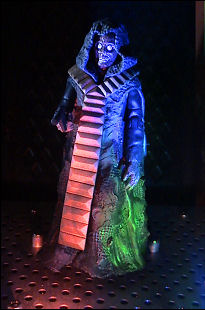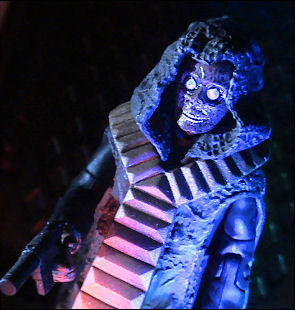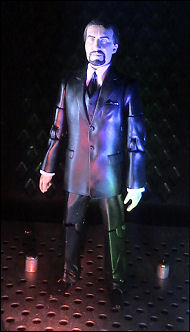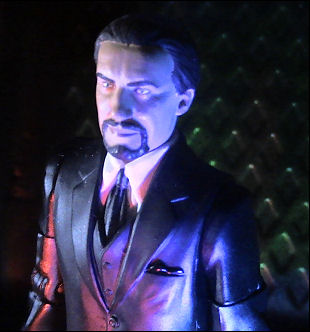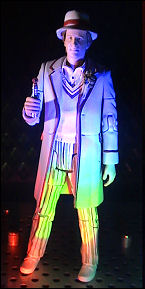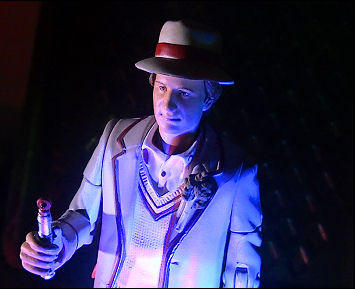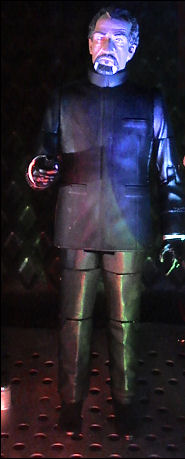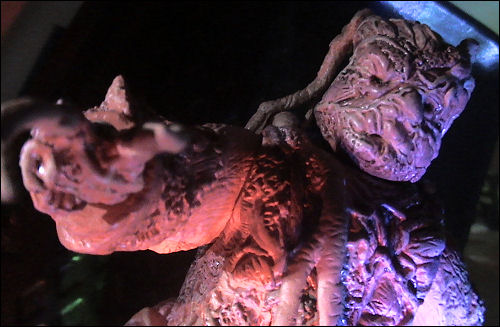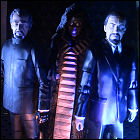 Though introduced seven years into the lengthy run of the original Doctor Who, few characters had as much of an impact on the show as The Master. The Doctor had proven to have a different morality than that held dear by the human race by urging UNIT to ask questions first and shoot later, but here was an enemy with whom there was no reckoning. The Master constantly used Earth as a playing piece in a larger game. By maneuvering it and its occupants into danger, he could throw his lifelong mortal enemy, the Doctor, off his stride. At least initially, the Master had no hatred of Earth whatsoever; inviting a steady stream of alien menaces to invade the planet was a ploy to distract the Doctor – preferably enough that the Master could finally have his revenge on his rival Time Lord.
Though introduced seven years into the lengthy run of the original Doctor Who, few characters had as much of an impact on the show as The Master. The Doctor had proven to have a different morality than that held dear by the human race by urging UNIT to ask questions first and shoot later, but here was an enemy with whom there was no reckoning. The Master constantly used Earth as a playing piece in a larger game. By maneuvering it and its occupants into danger, he could throw his lifelong mortal enemy, the Doctor, off his stride. At least initially, the Master had no hatred of Earth whatsoever; inviting a steady stream of alien menaces to invade the planet was a ploy to distract the Doctor – preferably enough that the Master could finally have his revenge on his rival Time Lord.
The Master’s arrival in plastic is also a major event in the Doctor Who action figure line from Character Options. The new series versions of the Master have already been produced as figures: John Simm was the Russell T. Davies era’s “current” Master, and appeared in no fewer than three guises: business-suited, in period clothes inherited from his previous incarnation (played by the great Derek Jacobi, who was far scarier in his very brief appearance as the Master than Simm ever quite managed to be), and in his unshaven, track-suit-wearing revived form from the final tenth Doctor adventure, The End Of Time. Even the Jacobi incarnation of the Master was given its own figure in a box set commemorating the third season episode Utopia; if this wasn’t the first time Derek Jacobi had ever been turned into an action figure, it was at least one of the classiest. (Collectors looking for this briefly-glimpsed version of the Master should look for him under his assumed name, Professor Yana.)
But the Master’s earlier incarnations were slow to arrive, and for good reason – all but one of the actors who have portrayed the Master in the original series have died.
The first classic series Master to arrive appeared as part of the unexpected second wave of classic figures, and it was indicative of the risk-averse approach to that second wave: by turning out a wave of figures with no human likenesses, there would be no pesky payments to actors or their estates. “Faceless” enemies like Ice Warriors, ’80s Cybermen, a robot mummy (from Pyramids Of Mars), yet another Robot of Death and the Frankenstein-inspired Morbius monster made sure that the only likenesses were those of masks made by the effects and design wizards of bygone eras of the BBC. The Master was also in this category, for the first classic series Master figure was based on the character’s cadaverous appearance in The Deadly Assassin, one of the Master’s three tussles with Tom Baker as the fourth Doctor. In that 1976 story, the character had no human face, only a ghastly skull mask dripping with spite and unspecified viscera that one didn’t want to think about too much. The figure replicates that mask frighteningly well, along with the tattered robes and the Sash of Rassilon that the Master kills so many of his fellow Time Lords to possess. For the record, this version of the Master was played by the late Peter Pratt, but his features were completely indistinguishable beneath the mask.
Some figure customizers, however, dissected this figure to find that the rubbery cloak concealed an outfit not unlike the Nehru suit worn by the Master’s first incarnation, perhaps a hint that someone at Character Options was thinking ahead. After all, if a body of the correct proportions has already been sculpted, only to be hidden beneath a pliable robe, then only a head is required to make a new figure out of that mostly-unseen body.
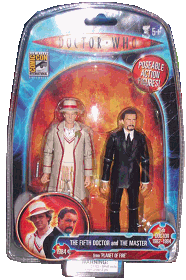 The next Master to appear, however, was the final incarnation seen in classic Doctor Who, as played by the late Anthony Ainley. Introduced at the 2010 San Diego Comic Con, this version of the Master did not wear the costume with which he was most closely associated. Billed as the Master from the penultimate fifth Doctor story, Planet Of Fire, this figure sported a business suit virtually identical to the one worn by the existing figure of John Simm as the Master, requiring only a new head sculpt. The sculpt in question was startlingly on-the-mark, even with Character’s good track record on human likenesses from the classic series: the cruel sneer with which Ainley often played the Master is preserved almost disturbingly well. Packaged with this Master was the fifth Doctor, in a unique variation wearing his trademark Panama hat. (Amusingly enough, the Master appears only briefly in the business suit in this episode, and when he does appear in that costume, he’s not actually the Master at all, but the shapeshifting android Kamelion doing the Master’s bidding. Even more strange is the fact that the Doctor doesn’t wear his full costume – jacket plus hat – for the entire story, opting to ditch the jacket due to the volcanically hot environment of the alien planet on which the story takes place.)
The next Master to appear, however, was the final incarnation seen in classic Doctor Who, as played by the late Anthony Ainley. Introduced at the 2010 San Diego Comic Con, this version of the Master did not wear the costume with which he was most closely associated. Billed as the Master from the penultimate fifth Doctor story, Planet Of Fire, this figure sported a business suit virtually identical to the one worn by the existing figure of John Simm as the Master, requiring only a new head sculpt. The sculpt in question was startlingly on-the-mark, even with Character’s good track record on human likenesses from the classic series: the cruel sneer with which Ainley often played the Master is preserved almost disturbingly well. Packaged with this Master was the fifth Doctor, in a unique variation wearing his trademark Panama hat. (Amusingly enough, the Master appears only briefly in the business suit in this episode, and when he does appear in that costume, he’s not actually the Master at all, but the shapeshifting android Kamelion doing the Master’s bidding. Even more strange is the fact that the Doctor doesn’t wear his full costume – jacket plus hat – for the entire story, opting to ditch the jacket due to the volcanically hot environment of the alien planet on which the story takes place.)
None of these little details displeased the fans, however; the word on the grapevine for the longest time was that Character simply wouldn’t spring for human likenesses beyond the eight classic Doctors for their pre-new-series toys. Ainley’s likeness was the first break in that particular dam.
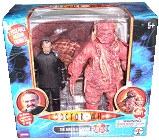 The second surprise came after Comic Con with the announcement of another two-pack, this time pairing the original Master, as played in the Jon Pertwee era by the late Roger Delgado, with a larger-than-usual action figure of an Axon creature from the Master’s third appearance, The Claws Of Axos (1971). Again, the resemblance of action figure to actor was uncanny, especially given that the modern technique of photographing actor and costume from every possible angle for merchandising purposes simply wasn’t the norm in 1971: the astonishingly good likeness of Delgado was achieved from existing publicity photos only. The one minor drawback here is that Delgado was dark and swarthy, whereas his figure is almost red-faced: the Master, a la Jersey Shore.
The second surprise came after Comic Con with the announcement of another two-pack, this time pairing the original Master, as played in the Jon Pertwee era by the late Roger Delgado, with a larger-than-usual action figure of an Axon creature from the Master’s third appearance, The Claws Of Axos (1971). Again, the resemblance of action figure to actor was uncanny, especially given that the modern technique of photographing actor and costume from every possible angle for merchandising purposes simply wasn’t the norm in 1971: the astonishingly good likeness of Delgado was achieved from existing publicity photos only. The one minor drawback here is that Delgado was dark and swarthy, whereas his figure is almost red-faced: the Master, a la Jersey Shore.
The Axon creature took an even more circuitous path to the toy shelves, however. Original plans for the second wave of classic Doctor Who villains called for a collect-and-build component, similar to the first wave’s collect-and-build K-1 Robot. The second wave’s collect-and-build figure, however, would have been the Krynoid, a vegetable-based predator seen in the Tom Baker story The Seeds Of Doom. However, in that iconic story, the Krynoid “suits” were merely reused alien costumes from The Claws Of Axos. So, for the Master two-pack, the Krynoid went back to its roots (ha!), delivered as a fully-assembled (and larger than usual) figure painted in shades of red, orange, and just about any other color you’d find on a pizza, as per the Axons’ very colorful original appearance. Its tentacles and inside-out, intestine-like skin are disturbingly well sculpted – and again, no likeness needed to be approved or paid for other than that of Mr. Delgado himself (who had already been turned into an action figure by Dapol a decade before, alongside their somewhat ungainly toy version of the third Doctor).
Only one actor who played the Master in the original Doctor Who survives to this day – Geoffrey Beevers – and he still occasionally plays the part for Big Finish’s audio dramas (his on-screen costume was a watered-down version of the gory Deadly Assassin Master, so don’t worry, no additional figure is necessary). This leaves only the Eric Roberts incarnation, who faced off against Paul McGann as the eighth Doctor; hopefully that version will appear in time.
